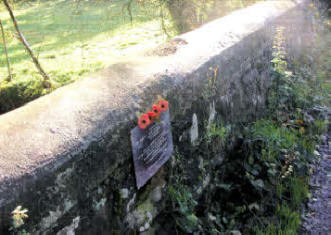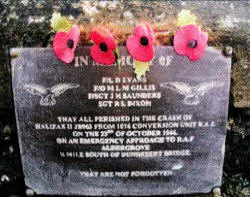Sacrifice that's still remembered 67 years on
by Eddie Mcllwaine

The scene of the crash
CRUMLIN: Every picture tells a story - and the photograph here tells an emotive tale of sacrifice during the last world war with the Remembrance services taking place on Sunday.
The last line on a plaque at Dundesert Bridge over the Six Mile Water River in south Antrim near Crumlin Village in memory of four RAF flyers killed in a WW2 accident proclaims the familiar phrase Gone but Not Forgotten.
And although the horrific crash of the Halifax bomber in which they lost their lives happened exactly 67 years ago in 1944 someone has indeed remembered the four dead heroes.
Four poppies have been pinned to the weather beaten plaque - one for each of the dead - which has been there almost unnoticed on the stone wall of the bridge on quiet Poplar Road since those blackout times.
Poplar Road is just two miles away from the Aldergrove camp which was an important RAF base with a vital role to play during the 1939-45 hostilities.

Passers by on the road have spotted that someone decided that in spite of the passage of time the poppies should be put in place in honour of Instructor Flight-Lieutenant David Evans DFC (27) RAFVR from Glamorgan, Canadian Pilot Flight Lieutenant Malcolm Gillis RCAF (26) , Flight Sergeant J.H. Saunders RAF (30) and Sergeant R.L. Dixon RAF (21) who perished in the crash which occurred in fields beyond the bridge.
On that October 23 1944 the Halifax bomber JB963 of No 1674 Heavy Conversion Unit involved in the training of RAF Coastal Command aircrew had just taken off from Aldergrove when it developed engine trouble and failed to gain height. Pilot Gillis was trying to return to the landing strip when the Halifax crashed close to the bridge where it exploded and caught fire, killing everyone on board.
The crash shocked local people even though they had become battle hardened with the deaths of more than 40 aircraft personnel on training missions out of Aldergrove during those grim war years.
Evans and Gillis, victims of the Dundesert horror, are buried in the cemetery of St Catherine's Parish Church at Aldergrove along with most of the other young flyers, average age 22, who lost their lives on training flights out of the base.
Ernie Cromie of the Ulster Aviation Society who has researched the crash says it was one of the worst accidents in the area at the time and he feels that members of the British Legion probably put up the poppies.
A special Remembrance service at which the crew of the Halifax and other RAF and Army victims of WW2 who lie buried in the St Catherine's graveyard, will be recalled, will take place in a hangar on the base which is now a joint RAF-Army site, on Sunday morning.
Ulster Star
11/11/2011

